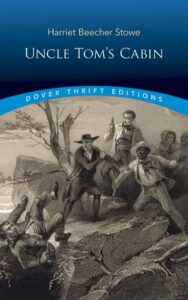
Book Summary
Uncle Tom’s Cabin is a famous book written by Harriet Beecher Stowe. It was published in 1852 and became very popular. The book tells the story of a kind-hearted slave named Uncle Tom and the challenges he faces in his life.
Uncle Tom’s Cabin is a very important book because it helped people understand the terrible things that happened to slaves in the past. It shows how slavery was wrong and how it affected the lives of many people. The book is sad at times, but it also teaches us about the power of love and friendship.
The story takes place in the southern United States during a time when slavery was legal. Uncle Tom is a slave who is sold to different owners and faces many hardships. He is separated from his family and friends, but he always stays strong and kind. Uncle Tom’s Cabin shows us that even in the toughest times, it is important to be kind and treat others with respect.
The book also introduces us to other characters like Eliza, who escapes from slavery with her son, and Eva, a young girl who befriends Uncle Tom. These characters show us the different experiences that slaves had and how they fought for their freedom.
Harriet Beecher Stowe was born in 1811 and was a writer and abolitionist. She wrote Uncle Tom’s Cabin to show people the cruelty of slavery and to try to change their minds about it. Her book became very popular and helped start a movement to end slavery. Harriet Beecher Stowe was an important figure in American history and her book continues to be read and studied today.
“Uncle Tom’s Cabin” is a seminal work in American literature, written by Harriet Beecher Stowe in 1852. The novel is a powerful indictment of the institution of slavery, which was prevalent in the United States during the 19th century. The book was instrumental in shaping the public opinion about slavery and played a significant role in the abolitionist movement. It is a compelling narrative that intertwines the lives of slaves, their masters, and those who sought to help them escape their bondage.
“Uncle Tom’s Cabin” is a deeply moving and thought-provoking novel. It tells the story of Uncle Tom, a long-suffering black slave, who maintains his faith in God despite the brutalities and injustices he faces. The novel also introduces us to other memorable characters such as Eliza, a slave who makes a daring escape to save her son, and Eva, the angelic daughter of a slave owner, whose love and innocence touch the hearts of those around her.
Stowe’s vivid descriptions and emotional storytelling bring to life the harsh realities of slavery. The novel is not just a tale of despair, but also a testament to the resilience of the human spirit and the power of faith. It is a heart-wrenching, yet inspiring read that leaves a lasting impression.
“Uncle Tom’s Cabin” is a complex and multi-layered novel. On one level, it is a social and political critique of slavery. Stowe uses her characters to expose the inhumanity and brutality of the institution. She also highlights the moral and spiritual corruption that slavery inflicts on the slave owners.
On another level, the novel is a religious allegory. Uncle Tom’s unwavering faith and his Christ-like forgiveness and love for his oppressors symbolize the Christian ideals of love, forgiveness, and sacrifice. The novel also explores themes of motherhood, family, and the power of love and compassion.
Stowe’s portrayal of the African American characters in the novel has been a subject of debate. While some critics argue that she reinforces racial stereotypes, others contend that she humanizes her black characters and gives them dignity and depth.
Harriet Beecher Stowe was born in Litchfield, Connecticut, in 1811. She was a prominent abolitionist and author. Stowe came from a religious family and her father, Lyman Beecher, was a well-known preacher. Her family’s commitment to social justice greatly influenced her writing.
Stowe wrote “Uncle Tom’s Cabin” in response to the Fugitive Slave Act of 1850, which required citizens to assist in the capture of escaped slaves. The novel was initially published as a serial in an abolitionist newspaper and later as a book. It became a bestseller and was translated into many languages.
Stowe continued to write novels, essays, and travel memoirs throughout her life. She used her writing to advocate for the abolition of slavery and for women’s rights. She died in 1896, but her legacy lives on through her powerful and influential works.
Don Quixote by Miguel de Cervantes
Miguel de Cervantes
Read Now →